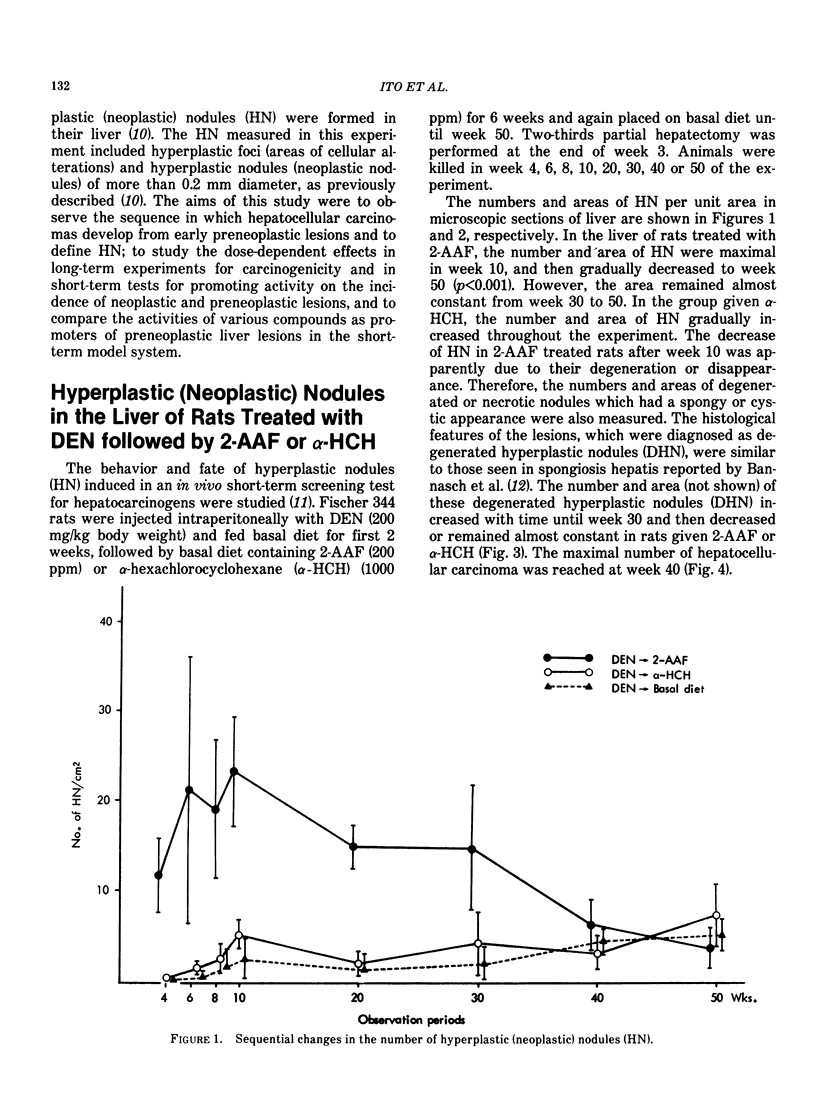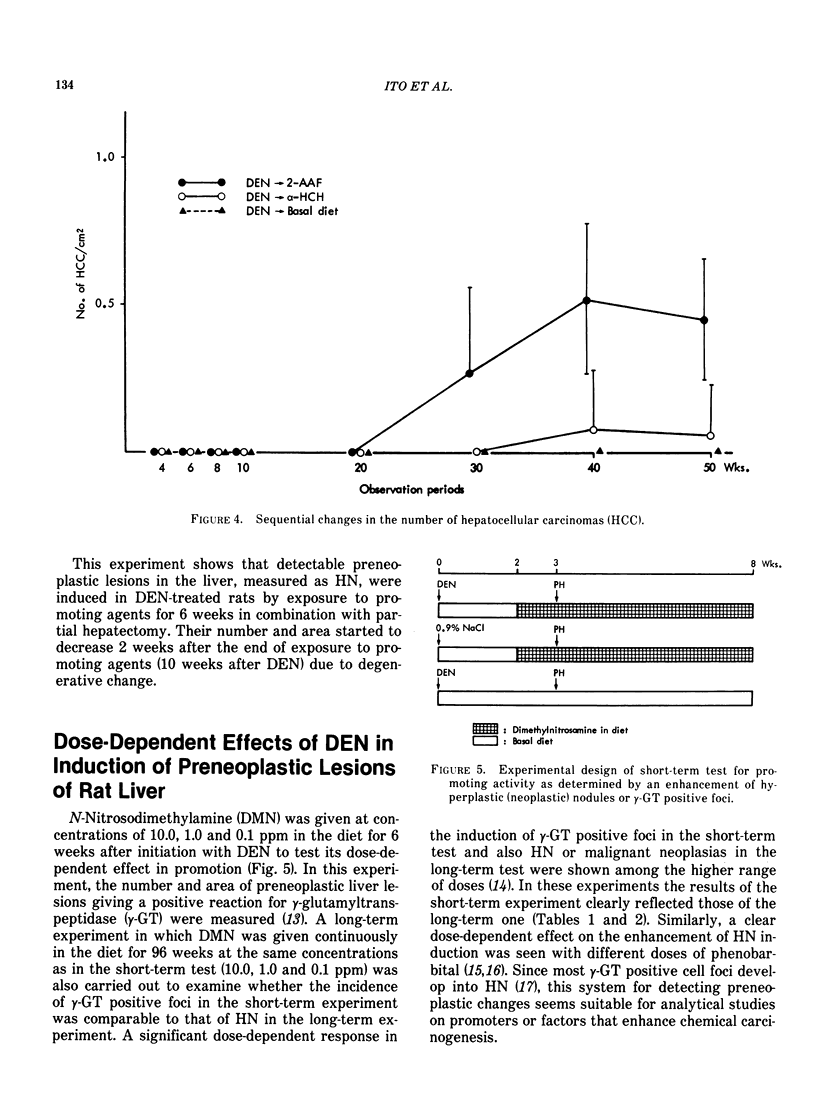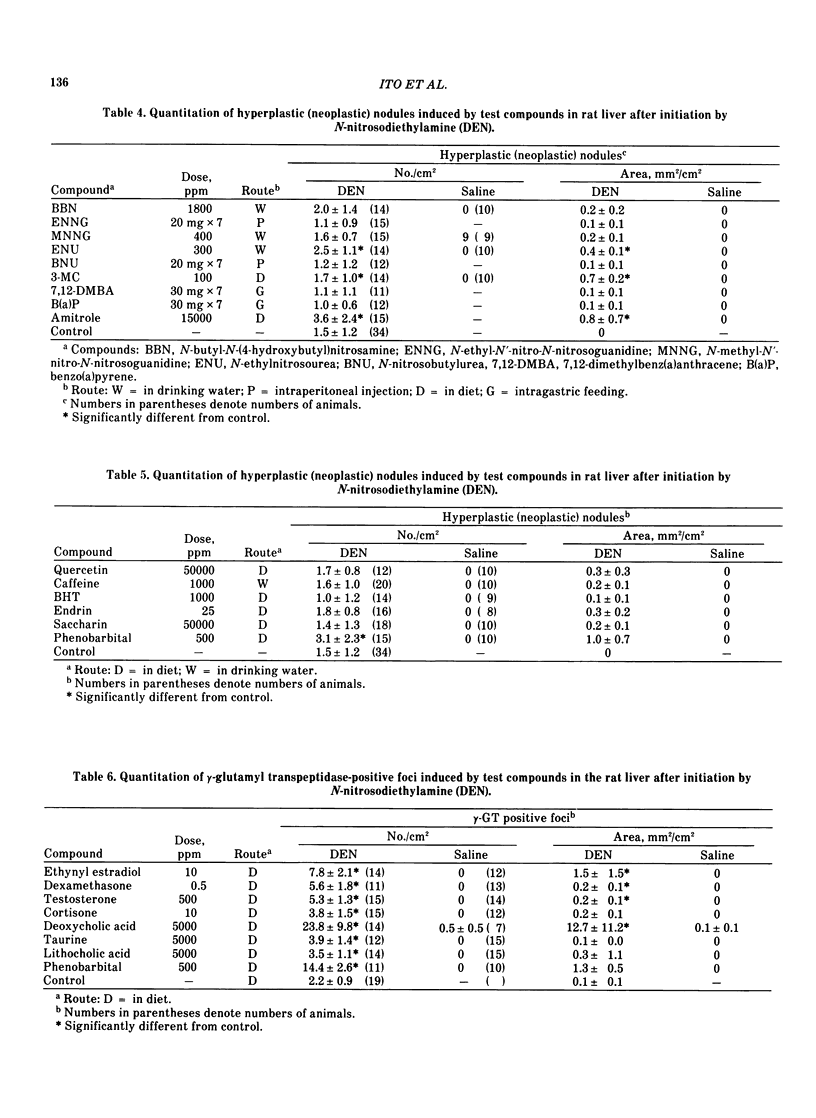Abstract
The promoting activities of 29 compounds on induction of hyperplastic (neoplastic) liver nodules (HN) and the dose-dependent effects of tumor promoting agents were compared by using a short-term test system developed in this laboratory. In tests on promoting activity, F344 rats were given a single dose (200 mg/kg) of N-nitrosodiethylamine (DEN), and from two weeks later, were treated with various test compounds for 6 or 10 weeks. They were subjected to partial hepatectomy 3 or 4 weeks after DEN treatment. The results showed that strong hepatocarcinogens, such as aflatoxin B1, DEN, N-nitrosodimethylamine (DMN), 2-acetylaminofluorene (2-AAF), 3'-methyl-4-dimethylaminoazobenzene (3'-Me-DAB) and ethionine, induced many hyperplastic liver nodules, whereas dieldrin, 1,1,1-trichloro-2,2-bis(4-chlorophenyl)ethane (DDT), polychlorinated biphenyls (PCB) and alpha-hexachlorocyclohexane (alpha-HCH) induced few lesions. Nonhepatocarcinogens, such as N-nitrosoethylurea (ENU) and 3-methylcholanthrene (3-MC), only slightly induced hyperplastic nodules. Of the miscellaneous compounds tested, phenobarbital, deoxycholic acid and ethynyl estradiol also induced gamma-glutamyl transpeptidase (gamma-GT) positive foci. In tests on the dose-dependent effects of promoting agents, DMN was given at different concentrations for 6 weeks from 2 weeks after DEN treatment. Results were quantitated by histochemical measurement of the number or area of gamma-GT positive lesions induced. A long-term experiment on the effect of feeding DMN for 96 weeks was also done. Clear dose-dependent effects of DMN were seen in induction of gamma-GT positive foci in the short-term experiment and neoplastic lesions in the long-term one.
Full text
PDF







Selected References
These references are in PubMed. This may not be the complete list of references from this article.
- Arai M., Aoki Y., Nakanishi K., Miyata Y., Mori T., Ito N. Long-term experiment of maximal non-carcinogenic dose of dimethylnitrosamine for carcinogenesis in rats. Gan. 1979 Aug;70(4):549–558. [PubMed] [Google Scholar]
- Armuth V., Berenblum I. Promotion of mammary carcinogenesis and leukemogenic action by phorbol in virgin female Wistar rats. Cancer Res. 1974 Oct;34(10):2704–2707. [PubMed] [Google Scholar]
- Bannasch P., Bloch M., Zerban H. Spongiosis hepatis. Specific changes of the perisinusoidal liver cells induced in rats by N-nitrosomorpholine. Lab Invest. 1981 Mar;44(3):252–264. [PubMed] [Google Scholar]
- Cameron R., Imaida K., Ito N. Promotive effects of ethinyl estradiol in hepatocarcinogenesis initiated by diethylnitrosamine in male rats. Gan. 1981 Apr;72(2):339–340. [PubMed] [Google Scholar]
- Cohen S. M., Arai M., Jacobs J. B., Friedell G. H. Promoting effect of saccharin and DL-tryptophan in urinary bladder carcinogenesis. Cancer Res. 1979 Apr;39(4):1207–1217. [PubMed] [Google Scholar]
- Hicks R. M., Wakefield J., Chowaniec J. Evaluation of a new model to detect bladder carcinogens or co-carcinogens; results obtained with saccharin, cyclamate and cyclophosphamide. Chem Biol Interact. 1975 Sep;11(3):225–233. doi: 10.1016/0009-2797(75)90101-5. [DOI] [PubMed] [Google Scholar]
- Ito N., Tatematsu M., Nakanishi K., Hasegawa R., Takano T., Imaida K., Ogiso T. The effects of various chemicals on the development of hyperplastic liver nodules in hepatectomized rats treated with N-nitrosodiethylamine or N-2-fluorenylacetamide. Gan. 1980 Dec;71(6):832–842. [PubMed] [Google Scholar]
- Nakanishi K., Hirose M., Ogiso T., Hasegawa R., Arai M., Ito N. Effects of sodium saccharin and caffeine on the urinary bladder of rats treated with n-butyl-n-(4-hydroxybutyl)nitrosamine. Gan. 1980 Aug;71(4):490–500. [PubMed] [Google Scholar]
- Ogawa K., Solt D. B., Farber E. Phenotypic diversity as an early property of putative preneoplastic hepatocyte populations in liver carcinogenesis. Cancer Res. 1980 Mar;40(3):725–733. [PubMed] [Google Scholar]
- Peraino C., Fry R. J., Staffeldt E. Reduction and enhancement by phenobarbital of hepatocarcinogenesis induced in the rat by 2-acetylaminofluorene. Cancer Res. 1971 Oct;31(10):1506–1512. [PubMed] [Google Scholar]
- Peraino C., Staffeldt E. F., Haugen D. A., Lombard L. S., Stevens F. J., Fry R. J. Effects of varying the dietary concentration of phenobarbital on its enhancement of 2-acetylaminofluorene-induced hepatic tumorigenesis. Cancer Res. 1980 Sep;40(9):3268–3273. [PubMed] [Google Scholar]
- Reddy B. S., Watanabe K., Weisburger J. H., Wynder E. L. Promoting effect of bile acids in colon carcinogenesis in germ-free and conventional F344 rats. Cancer Res. 1977 Sep;37(9):3238–3242. [PubMed] [Google Scholar]
- Takano T., Tatematsu M., Hasegawa R., Imaida K., Ito N. Dose-response relationship for the promoting effect of phenobarbital on the induction of liver hyperplastic nodules in rats exposed to 2-fluorenylacetamide and carbon tetrachloride. Gan. 1980 Aug;71(4):580–581. [PubMed] [Google Scholar]
- Tatematsu M., Murasaki G., Nakanishi K., Miyata Y., Shinohara Y., Ito N. Sequential quantitative studies on hyperplastic nodules in the liver of rats treated with carcinogenic chemicals. Gan. 1979 Feb;70(1):125–130. [PubMed] [Google Scholar]
- Tatematsu M., Takano T., Hasegawa R., Imaida K., Nakanowatari J., Ito N. A sequential quantitative study of the reversibility or irreversibility of liver hyperplastic nodules in rats exposed to hepatocarcinogens. Gan. 1980 Dec;71(6):843–855. [PubMed] [Google Scholar]
- Tsuda H., Lee G., Farber E. Induction of resistant hepatocytes as a new principle for a possible short-term in vivo test for carcinogens. Cancer Res. 1980 Apr;40(4):1157–1164. [PubMed] [Google Scholar]
- Weisburger J. H., Madison R. M., Ward J. M., Viguera C., Weisburger E. K. Modification of diethylnitrosamine liver carcinogenesis with phenobarbital but not with immunosuppression. J Natl Cancer Inst. 1975 May;54(5):1185–1188. doi: 10.1093/jnci/54.5.1185. [DOI] [PubMed] [Google Scholar]


